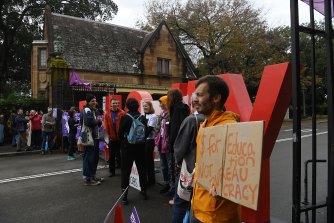‘No idea how rich’: Why Sydney University thrived despite the pandemic
By Jordan Baker
Towards the end of 2020, as universities confronted the financial nightmare of closed borders, Sydney University predicted a tough few years in which it would bleed international enrolments and lose half a billion dollars in revenue.
Most universities did suffer. But not Sydney. It surprised itself by becoming richer, posting a $1 billion operating surplus in 2021 as its investments thrived and it attracted a new type of Chinese student. One whose budget was able to extend to a top university only because they could stay at home and save money on travel and living expenses.

Staff and students at Sydney University are striking over pay and working conditions.Credit:Kate Geraghty
Sydney was saved by its reputation, said a senior sector insider, as were the rest of the “group of four” (University of NSW, Melbourne and Monash) whose rankings and prestige continued to attract students, although UNSW did not fare nearly as well as its older rival. “Among NSW unis, [Sydney has] the strongest international brand,” the insider said.
Things are looking up for harder-hit institutions, with universities’ annual reports showing most in the black and international students returning now borders have reopened. They have been led by those from the subcontinent, with federal education department figures showing international students from Nepal now make up the biggest group in Australia.
Many Nepalese and Indian students need to work during and after their degrees, often to repay the money they borrowed to pay for it, and the more generous post-degree work arrangements offered from January have attracted them back.
Chinese students are more likely to have stayed overseas, due to lockdowns in big cities, few commercial flights out of the country, long quarantine on return home and parental anxiety about sending students from a COVID-free to an Omicron-riddled environment. They tend to be wealthier and therefore a target market for Australia’s more expensive, top-ranking institutions.
Many are still in China, and some will finish their degree without having stepped onto Australian soil.
“As a result of the unanticipated influx of Nepalese and Indian students, the majority of universities in NSW and around Australia are doing well with an even better prospect for second semester,” said Phil Honeywood, the chief executive of the International Education Association of Australia. “Clearly, with China having been the number one market – 35 per cent of overseas higher ed students – for the sake of diversity we want Chinese students back here ASAP.”
University annual reports tabled in NSW parliament on Monday showed that vice chancellors who took over in the past year suffered a pay cut as chancellors and senates responded to widespread public and staff anger at climbing salaries.
UNSW boss Attila Brungs earns slightly less than the $1.09 million he got at the helm of the University of Technology Sydney, and almost half a million a year less than his predecessor.
Vice chancellor pay packets
University of NSW
- Previous vice chancellor: Up to $1.5 million
- New vice chancellor: $1.05 million
University of Technology, Sydney
- Previous vice chancellor: $1.09 million
- New vice chancellor: Up to $850,000
Sydney University
- Previous vice chancellor: Up to $1.62 million
- New vice chancellor: Up to $1.15 million
University of Wollongong
- Previous vice chancellor: $980,000
- New vice chancellor: Up to $619,999
The new vice chancellor of UTS, Andrew Parfitt, earns almost $250,000 less than Brungs, and Professor Patricia Davidson at the University of Wollongong earns more than $300,000 less than the previous boss.
For Sydney’s vice chancellor Mark Scott – who earns half a million dollars less than his predecessor – the financial results came at a difficult time. Academics want the university to spend its windfall on a pay rise of 5 per cent a year for three years, more permanent jobs and the preservation of the traditional workload split, which entitles them to reserve 40 per cent of their time for research.
“We suspected that the university didn’t have a money problem,” said the National Tertiary Education Union branch president Nick Riemer, who participated in the university’s third day of industrial action on Tuesday. “But we had no inkling of just how rich it is.
“Some of it is clearly one off. But I would be surprised if it was the case that as much of it was as one-off as they say.”
But Scott said the university’s financial position was still uncertain. Half the operational surplus came from returns on invested money – which was earmarked for capital works, or interest payments – as well as tied donations and property sales.
The other half was partly driven by the unexpected willingness of international students to keep learning online, which might not last, as well as tight controls on spending that were introduced early in the pandemic. “We are concerned that the longer students stay offshore, the harder it will be to hold them,” said Scott. “That’s why we feel that the circumstances of this result, even in an operational sense, are one off.
“I can assure staff that we are looking to sensibly invest this good result where we can in the quality of teaching and learning and the quality of research and to create as supportive an environment as possible for staff to do great work at the university. We are already the highest-paying university in the sector.”
With the change of federal government, Scott urged the sector to avoid sending off logs of demand, but “to sit down and listen carefully to the government’s understanding of the major challenges it faces and we face as a society, and for the university sector to provide constructive solutions to some of those challenges.”
The Morning Edition newsletter is our guide to the day’s most important and interesting stories, analysis and insights. Sign up here.